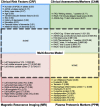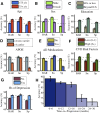Predicting Progression from Mild Cognitive Impairment to Alzheimer's Dementia Using Clinical, MRI, and Plasma Biomarkers via Probabilistic Pattern Classification
- PMID: 26901338
- PMCID: PMC4762666
- DOI: 10.1371/journal.pone.0138866
Predicting Progression from Mild Cognitive Impairment to Alzheimer's Dementia Using Clinical, MRI, and Plasma Biomarkers via Probabilistic Pattern Classification
Abstract
Background: Individuals with mild cognitive impairment (MCI) have a substantially increased risk of developing dementia due to Alzheimer's disease (AD). In this study, we developed a multivariate prognostic model for predicting MCI-to-dementia progression at the individual patient level.
Methods: Using baseline data from 259 MCI patients and a probabilistic, kernel-based pattern classification approach, we trained a classifier to distinguish between patients who progressed to AD-type dementia (n = 139) and those who did not (n = 120) during a three-year follow-up period. More than 750 variables across four data sources were considered as potential predictors of progression. These data sources included risk factors, cognitive and functional assessments, structural magnetic resonance imaging (MRI) data, and plasma proteomic data. Predictive utility was assessed using a rigorous cross-validation framework.
Results: Cognitive and functional markers were most predictive of progression, while plasma proteomic markers had limited predictive utility. The best performing model incorporated a combination of cognitive/functional markers and morphometric MRI measures and predicted progression with 80% accuracy (83% sensitivity, 76% specificity, AUC = 0.87). Predictors of progression included scores on the Alzheimer's Disease Assessment Scale, Rey Auditory Verbal Learning Test, and Functional Activities Questionnaire, as well as volume/cortical thickness of three brain regions (left hippocampus, middle temporal gyrus, and inferior parietal cortex). Calibration analysis revealed that the model is capable of generating probabilistic predictions that reliably reflect the actual risk of progression. Finally, we found that the predictive accuracy of the model varied with patient demographic, genetic, and clinical characteristics and could be further improved by taking into account the confidence of the predictions.
Conclusions: We developed an accurate prognostic model for predicting MCI-to-dementia progression over a three-year period. The model utilizes widely available, cost-effective, non-invasive markers and can be used to improve patient selection in clinical trials and identify high-risk MCI patients for early treatment.
Conflict of interest statement
Figures







Similar articles
-
Structural magnetic resonance imaging for the early diagnosis of dementia due to Alzheimer's disease in people with mild cognitive impairment.Cochrane Database Syst Rev. 2020 Mar 2;3(3):CD009628. doi: 10.1002/14651858.CD009628.pub2. Cochrane Database Syst Rev. 2020. PMID: 32119112 Free PMC article.
-
Incremental value of biomarker combinations to predict progression of mild cognitive impairment to Alzheimer's dementia.Alzheimers Res Ther. 2017 Oct 10;9(1):84. doi: 10.1186/s13195-017-0301-7. Alzheimers Res Ther. 2017. PMID: 29017593 Free PMC article.
-
Combination of Plasma Neurofilament Light Chain and Mini-Mental State Examination Score Predicts Progression from Mild Cognitive Impairment to Alzheimer's Disease within 5 Years.J Alzheimers Dis. 2021;82(3):951-964. doi: 10.3233/JAD-210092. J Alzheimers Dis. 2021. PMID: 34120902
-
Increased prediction value of biomarker combinations for the conversion of mild cognitive impairment to Alzheimer's dementia.Transl Neurodegener. 2020 Aug 3;9(1):30. doi: 10.1186/s40035-020-00210-5. Transl Neurodegener. 2020. PMID: 32741361 Free PMC article.
-
Role of Blood P-Tau Isoforms (181, 217, 231) in Predicting Conversion from MCI to Dementia Due to Alzheimer's Disease: A Review and Meta-Analysis.Int J Mol Sci. 2024 Nov 30;25(23):12916. doi: 10.3390/ijms252312916. Int J Mol Sci. 2024. PMID: 39684623 Free PMC article. Review.
Cited by
-
A Deep Neural Network-Based Method for Prediction of Dementia Using Big Data.Int J Environ Res Public Health. 2021 May 18;18(10):5386. doi: 10.3390/ijerph18105386. Int J Environ Res Public Health. 2021. PMID: 34070100 Free PMC article.
-
Early diagnosis of Alzheimer's disease using combined features from voxel-based morphometry and cortical, subcortical, and hippocampus regions of MRI T1 brain images.PLoS One. 2019 Oct 4;14(10):e0222446. doi: 10.1371/journal.pone.0222446. eCollection 2019. PLoS One. 2019. PMID: 31584953 Free PMC article.
-
Prediction of dementia risk from multimodal repeated measures: The added value of brain MRI biomarkers.Alzheimers Dement (Amst). 2024 May 25;16(2):e12578. doi: 10.1002/dad2.12578. eCollection 2024 Apr-Jun. Alzheimers Dement (Amst). 2024. PMID: 38800122 Free PMC article.
-
Artificial Intelligence for Dementia Research Methods Optimization.ArXiv [Preprint]. 2023 Mar 2:arXiv:2303.01949v1. ArXiv. 2023. Update in: Alzheimers Dement. 2023 Dec;19(12):5934-5951. doi: 10.1002/alz.13441. PMID: 36911275 Free PMC article. Updated. Preprint.
-
Development of a machine learning model to predict mild cognitive impairment using natural language processing in the absence of screening.BMC Med Inform Decis Mak. 2022 May 12;22(1):129. doi: 10.1186/s12911-022-01864-z. BMC Med Inform Decis Mak. 2022. PMID: 35549702 Free PMC article.
References
-
- Korolev IO. Alzheimer’s Disease: A Clinical and Basic Science Review. Medical Student Research Journal. 2014;4: 24–33.
Publication types
MeSH terms
Substances
Grants and funding
LinkOut - more resources
Full Text Sources
Other Literature Sources
Medical

